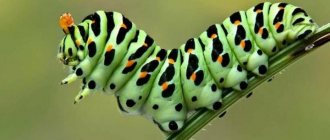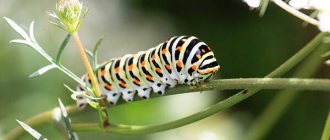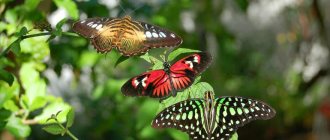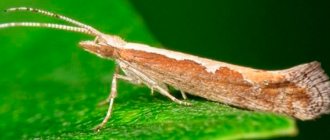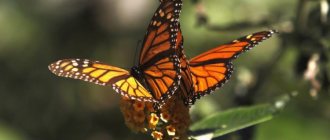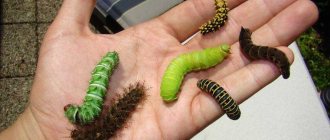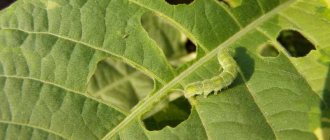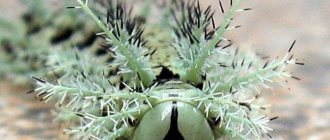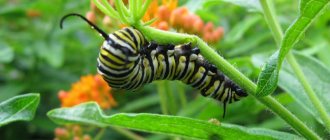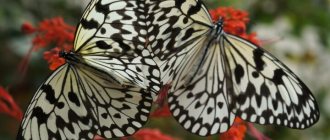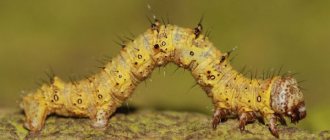Numerous orders of insects are conventionally divided into two groups. In representatives of the first group, the larvae emerging from the egg are similar to adult individuals and differ from them only in the absence of wings. These include cockroaches, grasshoppers, locusts, bedbugs, praying mantises, stick insects, etc. These are insects with incomplete transformation. In the second group, the eggs hatch into worm-like larvae, completely different from their parents, which then turn into pupae, and only after that do adult winged insects emerge from the pupae. This is the development cycle of insects with complete transformation. These include mosquitoes, bees, wasps, flies, fleas, beetles, caddis flies, and butterflies.
Where do caterpillars come from: the life cycle of butterflies
The female lays eggs after fertilization.
Under favorable conditions, a larva develops inside. The process takes from 2 to 14 days. Upon completion, they gnaw through the rim of the eggs and crawl out. This is how the caterpillar appears. The size of the first stage larvae is about 1 mm. They are born with a huge appetite, eat a lot, and grow quickly. As they grow older, they undergo an average of 4 molts, but there are species that are reborn up to 16 times. The duration of this cycle depends on the type of insect and habitat. In our area, females manage to give birth to two generations; the larva develops in about 6 weeks.
Caterpillars live under the bark of trees, in cereals, grains, and under the leaves of various plants. They feed on juices and gain strength. At the imago stage, the moth lives from several days to 20 days. During this time, it either does not eat anything or feeds on plant nectar, juices of berries, and fruits.
Interesting!
In northern latitudes, the larva does not have time to go through the full development cycle in one summer; it remains to winter in this form and continues to develop with the onset of warmer weather. Northern species are able to withstand frosts below -70 degrees Celsius. In Greenland and Canada, the transformation of a caterpillar into a butterfly lasts 7-14 years.
Finally, the larva forms a cocoon from independently produced threads and turns into a pupa. It clings to the tree and leaves with its paws and freezes. The most mysterious phenomenon begins - the transformation into a moth.
Life cycle of butterflies
Caterpillar structure
The body of caterpillars consists of thirteen segments, of which three are thoracic and ten are abdominal. The thoracic segments bear a pair of jointed legs; the abdominal segments usually have five pairs of false legs; some types of abdominal legs have two or three pairs, or they are underdeveloped. The appearance of caterpillars is very diverse and often differs even among closely related species.
Many are brightly and variegatedly colored, some have outgrowths in the form of horns, spikes, and bumps. The surface of the body is smooth with sparse scales or covered with dense hairs, warts, and spines. Body proportions also vary: some caterpillars are short and thick, others are thin and long.
What is metamorphosis and why is it needed?
Metamorphosis, i.e. a life cycle with a series of successive transformations is a very successful acquisition in the struggle for existence. Therefore, it is widespread in nature and is found not only in insects, but also in other living organisms. Metamorphosis allows different stages of the same species to avoid competition among themselves for food and habitat. After all, the larva eats different food and lives in a different place; there is no competition between the larvae and adults. Caterpillars gnaw leaves, adult butterflies calmly feed on flowers - and no one bothers anyone. Through metamorphosis, the same species simultaneously occupies several ecological niches (feeding on both leaves and flowers in the case of butterflies), which also increases the species' chances of survival in an ever-changing environment. After the next change, at least one of the stages will survive, which means the entire species will survive and continue to exist.
Are caterpillars a separate species of insect?
Caterpillars are not representatives of a separate species, order or suborder of insects. This is one of the stages of development of butterflies - insects belonging to the order Lepidoptera. A caterpillar is a butterfly larva that hatches from an egg and eventually turns into a pupa, from which a beautiful butterfly will actually emerge.
Caterpillar
Until the transformation of a caterpillar into a butterfly occurs, the larva has to face many dangers. To survive, caterpillars use various methods of defense. Some scare away with their bright colors, others with an unpleasant odor, and still others are completely poisonous.
Butterfly breeding
The shape and color of the wings are of great importance when breeding butterflies. Some species are sexually dimorphic: males and females differ in appearance, which makes it easier for lepidopterans to find a partner. Other species use pheromones to attract mates. Depending on the species, either males or females can attract a partner in this way. The mating dance is also characteristic of butterflies.
Mating occurs on plant leaves or the ground. It can last from 20 minutes to several hours. By fertilizing a female, the male not only transfers his seed, but also components that are useful during pregnancy. Some species have an interesting feature: after fertilization, a chitinous appendage appears on the female’s abdomen, which eliminates the possibility of repeated mating.
The mating process of the heliconid charitonia is interesting. The female begins to emit pheromones several hours before emerging from the pupa. Males flock to her and begin to fight with each other. The winning male fertilizes the pouch as it emerges from the pupa.
After fertilization, the female lays eggs. This is how butterflies are born. In the tropics, some species can produce up to three generations in one year.
Doll
To find out how butterflies are born, it is worth considering the processes that occur inside the pupa. The pupa is motionless and cannot escape from a predator, therefore this is the most defenseless stage in the life of a butterfly. That is why the dolls have such a variety of shapes and colors. They camouflage themselves with foliage and greenery. Some butterflies (such as silkworms) spin protective cocoons that provide additional protection.
With the help of the juice with which the caterpillar digests food, it liquefies its own body. The cells that are formed as a result of this process are called imaginal. They are able to change properties depending on the organ they are to become.
In most cases, the complete transformation from caterpillar to butterfly takes approximately two weeks. There are species in which this process can last for several years. The rate of development of the butterfly in the pupa depends on the external temperature and humidity. Some butterflies pupate before winter to survive the cold.
Stages of butterfly development
Butterflies are insects with a full cycle of transformation, that is, they go through all stages of development:
- egg;
- larva (caterpillar);
- chrysalis;
- imago (adult).
Each stage of the transformation of a caterpillar into a butterfly takes time and has its own characteristics.
Egg
First, the adult butterfly lays an egg and thereby gives rise to a new life. Depending on the type, eggs can be round, oval, cylindrical, conical, flattened and even bottle-shaped. Eggs differ not only in shape, but also in color (usually they are white with a green tint, but other colors are not so rare - brown, red, blue, etc.).
The eggs are covered with a dense hard shell - the chorion. The embryo located under the chorion is equipped with a supply of nutrients, very similar to the well-known egg yolk. It is by this that the two main life forms of lepidopteran eggs are distinguished. Eggs of the first group are poor in yolk. Those species of butterflies that lay such eggs develop inactive and weak caterpillars. Outwardly, they look like tadpoles - a huge head and a thin, thin body. Caterpillars of such species must begin to feed immediately after emerging from the egg, only after which they acquire fully plump proportions. That is why butterflies of these species lay eggs on a food plant - on leaves, stems or branches. Eggs placed on plants are typical for diurnal butterflies, hawk moths, and many cutworms (especially lancets).
In other butterflies, eggs are rich in yolk and provide the development of strong and active caterpillars. Having left the egg shell, these caterpillars immediately begin to crawl away and are able to cover sometimes quite significant distances for them before finding suitable food. Therefore, butterflies that lay such eggs do not need to worry too much about their placement - they lay them wherever they need to. Thinworms, for example, scatter eggs on the ground in bulk right on the fly. In addition to slender moths, this method is typical for bagworms, glassworts, many moths, cocoon moths and bear moths.
There are also lepidoptera that try to bury their eggs in the ground (some cutworms).
The number of eggs in a clutch also depends on the species and sometimes reaches 1000 or more, however, not all survive to the adult stage - this depends on factors such as temperature and humidity. In addition, butterfly eggs have no enemies from the insect world.
The average duration of the egg stage is 8-15 days, but in some species the eggs overwinter and this stage lasts months.
From chrysalis to butterfly
While in chrysalis form, caterpillars are most vulnerable. They are motionless and cannot protect themselves from predators - birds and insects. The only thing that saves them is that the cocoon usually looks unpretentious and does not stand out much from the background of the environment.
Despite the fact that no movements are noticeable from the outside, many complex processes are taking place inside the cocoon at this time. The transformation from a larva to an adult (imago) in butterflies is called metamorphosis. The final form of the insect is almost completely different from the intermediate one, namely the larva. The only way to recognize the former caterpillar is by its legs.
In the case of butterflies, the caterpillar, once in a cocoon, secretes special substances, under the influence of which its body becomes liquid. In this mass, imaginal discs are preserved, that is, clusters of cells responsible for the formation of new tissues and organs of the future butterfly.
When the metamorphosis is completely completed, the insect secretes enzymes that corrode the shell, after which the butterfly can get out of the cocoon. First the head appears, then the body and legs squeeze through.
Immediately after the butterfly appears, it cannot yet fly. Her wings are wet and curled. The insect crawls higher and sits motionless until the wings straighten, dry and become strong. After this, the butterfly can go on its first flight in order to find a mating partner, then lay eggs and continue the butterfly genus.
How long does the transformation take?
The time that passes from the moment the pupa is formed until the butterfly appears varies significantly depending on the type of insect, climate zone and environmental conditions. In most cases, the rebirth process takes 2-3 weeks. But in some species, the pupa takes much longer to transform into a butterfly. Some species overwinter in pupal form, while others spend several years in this state. For example, in the fluffy cocoon moth, the pupal stage can last up to 8 years. If conditions outside are unfavorable, then the butterfly is in no hurry to appear and waits.
It is difficult to predict what a butterfly will be like based on the appearance of a caterpillar. Sometimes the larva and the adult insect are completely different, and in some cases the similarity is noticeable to the naked eye.
Imago
An adult insect, the imago, emerges from the pupa. The shell of the pupa bursts, and the imago, clinging to the edge of the shell with its feet, while exerting a lot of effort, crawls out.
A newborn butterfly cannot fly yet - its wings are small, as if curled, and wet. The insect necessarily climbs to a vertical elevation, where it remains until it fully spreads its wings. In 2-3 hours, the wings lose their elasticity, harden and acquire their final color. Now you can take your first flight!
The lifespan of an adult varies from several hours to several months, but on average the lifespan of a butterfly is only 2-3 weeks.
VKontakteFacebookOdnoklassnikiMy World Headings Insects 2 comments Post navigation Butterfly Gardens Butterflies Dippers
The benefits and harms of butterflies
The benefit or harm that butterflies bring largely depends on what stage of development the insects are at. Thus, the vast majority of caterpillars are pests that destroy both agricultural and wild plants. But adult butterflies participate in the pollination of many plants.
For reference! Many scientists are of the opinion that the role of butterflies in the pollination process is greatly exaggerated. When they drink nectar, they prefer not to get their paws dirty with pollen, which means they don’t transfer it to other plants.
Larvae and adult butterflies are food for birds and insectivorous animals. Some varieties of caterpillars feed on insect pests. Speaking about the benefits of butterflies, one cannot fail to mention the silkworm, which is used in the production of natural silk.
Well, of course, one cannot downplay the aesthetic significance of butterflies in human life. They help to understand and enjoy the beauty of nature.
How to raise an insect
It is possible to create an ideal living environment, but you need to consider a few important things:
- Take a clean food container.
- Fold the paper towel and place it at the bottom of the container.
- Place a regular dry stick or popsicle stick (or two) into the container.
- Carefully place the caterpillar into the container. If it is on a sheet, place the sheet with it.
- If the insect was on the plant and is still eating, store fresh leaves in a container until pupation.
- If the insect sways, it needs to be cleaned. You may need to replace the paper towel from time to time.
- If an insect crawls into a paper towel and disappears, it is probably hiding before pupating.
- Once it pupates, the butterfly will hatch.
The process of turning a larva into an adult butterfly takes a long time, and during most of this period nothing seems to happen. It's even difficult to tell whether the caterpillar is alive or not. The pupal stage can last weeks and often months—many species pupate throughout the winter and hatch the following summer.
What do caterpillars eat?
Caterpillars of most butterfly species feed on green parts of plants - leaves, flowers, unripe fruits. Some develop inside branches and trunks, feed on wood, on lichens and dead parts of plants, on animal remains such as wool, down, feathers, and also on wax.
Some species are predatory, feeding on ant larvae and scale insects.
Requirements for growing a butterfly from a caterpillar at home
- Several caterpillars, the brighter and thicker the caterpillars, the more beautiful your butterflies will grow.
- The caterpillar's food is the grass or leaves on which you found the caterpillar.
- A butterfly incubator is an ordinary salofan bag or a three-liter jar.
- The waiting time is usually several weeks and not more than a month.
I will tell my story of how I raised a butterfly from a caterpillar at home (I was in third grade at the time) and the play, explaining your actions.
- I found several identical caterpillars on a bush and collected a dozen. I picked up a full package of these leaves and twigs. So, when you find the caterpillars, you should do the same. If you find a caterpillar on the asphalt and want to turn it into a butterfly, then search the Internet for this caterpillar and find out what plant it eats.
- At home, I made two incubators. I put twigs with leaves in the bag, filling 40% of the bag space. I made holes in the bag with a regular nail to allow air for my pets. Everything is easy here, just repeat. Do not skimp on the number of holes, and place the holes in the middle and top parts of the bag.
- I placed 5 of my caterpillars in one house, 5 in another. And he didn’t throw them in one pile, but spread them out evenly, although I think they might crawl back to their places on their own. Then he tied the bag on top and put it in a place where it was neither dark nor light. No matter what, the sun doesn’t fall on them, but no matter what, they don’t have eternal night. Place it on a corner of a shelf, or a table, or a bedside table, decide for yourself depending on your utility capabilities.
- I constantly looked and observed, the first days they only crawled along the branches and ate leaves. The spectacle was not exciting, boring and not interesting. But we have to wait!
- After about a week there was a lull, when I looked closely I saw that there were no caterpillars! There are cocoons, how they wrapped themselves in them, I don’t even know if I missed this moment. Further, it’s even more boring to watch them, they hang stupidly and that’s it. But we wait further.
- I don’t remember how many days passed there, but I saw the chrysalises and again missed the moment when the cocoon becomes a chrysalis. There was a suspicion that this was happening at night, but in fact, I just rarely looked there. I was interested in the end result.
- One fine morning, around 11 o'clock, I woke up from a strange noise. There was something rustling in the bag. I took a closer look and saw that a yellow butterfly was fluttering there. Surprisingly, it happened. Like a savage, I put my hand in the bag and began to catch it, naturally I scratched the enamel on its wings with my fingers, gently grabbed it by the abdomen and on the balcony released it into the street and it flew away. I returned to my bags and saw a small head bursting out of the pupa into the light of day. She worked hard and for a long time to get out. Sometimes I wanted to reach out and help, but I stopped myself with the thought that I could only do harm. So don’t stop nature from doing its thing, don’t pretend to be surgeons!
- And when the butterfly crawled out before my eyes, I put my hand up and it, having just been born, was not afraid of me at all. I could pick her up and carry her, put her down and pick her up again, she only climbed, but didn’t fly. There was a thought that she was disabled and wouldn’t fly, but still, she flew up and continued to contact me without fear, allowing herself to be picked up (naturally not by the wings). This is just a miracle! I now know that she didn’t fly because her wings needed to dry.
With it, I did the same as with the first butterfly, took it to the balcony and released it, it circled around me for a long time, as if it was saying goodbye or did not want to part, but the smell of freedom gave it new sensations and it fluttered high into the air. That’s what I thought at the time, isn’t it impressive? ?
Unfortunately, the remaining 8 caterpillars died. Nothing hatched from their pupae. Perhaps they did not have enough food supplies, perhaps the conditions were not the same or there were few holes, but most likely it was a bit dry, since they need 80-60% humidity. But in any case, out of 10 caterpillars I have, 2 butterflies were born without much care.
We invite you to read: Advantage for nursing cats
Well, in conclusion, I’ll tell you that you can make money from butterflies (I wrote about this in the article Fear of Retirement), but growing a butterfly at home is not difficult and you don’t need any investment.
How to care for a domestic butterfly?
Keeping butterflies at home begins with preparing a clean, transparent plastic or glass container. It should contain plants as food, soil and twigs on which the caterpillar can crawl and later pupate. Such a container must be covered with a fine mesh or gauze for good ventilation.
It is important to feed the leaves of the tree or bush on which the caterpillar was found. Some species are able to feed on different plants
But the majority prefer one thing - it’s easier for them to die than to eat unfamiliar food
Some species are able to feed on different plants. But the majority prefer one thing - it’s easier for them to die than to eat unfamiliar food.
Leaves must be changed daily. They can be washed and soaked in water - this will be an additional source of moisture for the caterpillar. To keep them fresh throughout the day, they can be placed in tubes of flower water. Larger containers in the form of vases or jars are not a good option. The caterpillar can easily fall into them and die.
The container with the caterpillar should be located in a constant temperature indoors. To maintain moisture, it can be sprayed with a spray bottle.
It is necessary to clean the caterpillar's home every day. For convenience, you can put paper towels at the bottom of the container. Caterpillars are very voracious, so they excrete a lot of excrement. Therefore, paper will make the cleaning task easier.
When the caterpillar reaches the maximum size for its species, the pupation stage will begin. During this period, the caterpillar may change color, eat less, and become lethargic. Over the course of two or three days, the pupation process occurs. A suitable temperature is considered to be 26-28⁰C with humidity up to 90%. It is necessary to periodically irrigate the container for optimal development conditions.
The pupa should be located in a part where there is enough space to spread its wings. It may be necessary to move the leaf or twig to a more favorable point in the container.
It happens that the pupa dies - in this case the cocoon is darker. If you gently bend it and the color does not change, then it is dead.
The adult individual - the imago - appears after a few days, or even weeks. After emerging from the cocoon, the butterfly does not eat for a couple of hours. She spends this time opening and drying her wings. It’s good when there are vertical branches or sticks next to the doll, on which the lepidopterous beauty can sit comfortably.
When is it dangerous to help?
One day a man found a butterfly cocoon and took it home. He decided to observe the transformation process. The cocoon opened, and for several hours in a row this man observed the difficulties the butterfly had to go through in order to get out. She tried to get out through the small hole for quite a long time and suddenly the moment came when it seemed to him that the butterfly had given up and stopped fighting. It looked like she was stuck and completely motionless.
Taking pity on her, the man decided to help her and cut off the cocoon. Thanks to this, the butterfly got out of the cocoon, but its body was swollen like a caterpillar, its wings were small and unopened. The man expected her wings to strengthen and grow and her body to transform, but nothing else happened. The butterfly pitifully dragged its swollen body in a circle, now doomed to do this for the rest of its life.
Man, out of his kindness, did not understand that he had interfered with the natural process of nature. The efforts that the butterfly made were simply necessary for metamorphosis. Making its way through the narrow opening of the cocoon, the liquid from the butterfly's body would pass into the wings, making them large and strong for flight. By depriving the butterfly of its struggle, man doomed it to a miserable existence and deprived it of a wonderful future. Likewise, people become strong and successful and transform into a better image only when they go through certain difficulties and put in a lot of effort.
Sources:
https://www.lepidopterolog.ru/metamorf#:
https://www.krasnouhie.ru/zhiznennyj-cikl-babochek-metamorfoz-razvitie-babochki.html
https://www.danaida.ru/obsh/razm.htm
Order of butterflies, or Lepidoptera
Lepidoptera are the largest group of insects from the phylum arthropods. A characteristic feature of all representatives of the order of butterflies is the scaly multi-colored cover of the body and wings. These scales are nothing more than modified hairs. They have different colors and can create complex and bizarre patterns. These patterns serve as camouflage, hiding the insect or signaling inedibility. For most species, patterns on the wings are of an identifying nature so that individuals of the same species can recognize each other.
Another identifying feature of the order of butterflies is the sucking mouthparts in the form of a long tubular proboscis. To eat, the butterfly extends its long proboscis, plunges it deep into the flower and sucks up the nectar.
The main source of food for the order of butterflies is the nectar of flowers, so they are considered the main pollinators of flowering plants. There is an opinion that with the advent of flowers on Earth, butterflies appeared.
The meaning of butterflies in human life
In the silk industry, man uses the silkworm as a fiber producer. Some butterfly caterpillars feed only on weeds, so they are sometimes used as biological weapons against the latter. That is, caterpillars (for example, American cactus moth) are released into places where weeds have grown heavily and they eat harmful plants.
Butterflies can also cause harm. Some caterpillars cause untold damage to forest and agricultural crops. Caterpillars of winter, flax, wheat, and cabbage cutworms infect vegetable gardens or sugar beet fields. And cabbage was considered a real threat to vegetable growers and gardeners. Hawthorn harms cherries and pears.
Methods of dealing with caterpillars
The appearance of caterpillars on plants does not bode well. These voracious insects can cause serious harm to a crop and even cause its death. In this case, at the first signs of their vital activity, it is necessary to take urgent measures to save the plants.
The following insecticides can be used to control caterpillars:
- Bitoxibacillin;
- Iskra M;
- Inta-vir;
- Senpai;
- Monsoon;
- Lepidocide.
To prevent damage, you can use decoctions based on tobacco leaves, chamomile, onion peels, tomato tops, and yarrow. The smell of these plants can scare off flying individuals, and they will not be able to lay eggs.
Nutritional Features
Basically, insects prefer to eat pollen, flower nectar, tree sap, overripe fruits, but there are also special species that are picky eaters. For example, the hawk moth, a honey lover, enters the hive and enjoys its favorite food. Some members of the nymphalid family replenish moisture loss by eating the urine and sweat of wild and domestic animals. Some tropical butterflies prefer crocodile tears as moisture.
Insects, which do not have a mouthpart at all and live extremely short lives, use supplies that were made when the caterpillar found it. Some types of butterflies are real vampires. They replenish lost strength by consuming animal blood.
How many species of butterflies are there on our planet?
To describe all the types of butterflies and their names, our article will probably not be enough - there are about two hundred thousand species on Earth. Lepidoptera lived alongside other animals since the Jurassic period - this is confirmed by archaeological finds. Nowadays, beautiful representatives of this order can be found on any continent except Antarctica.
Butterflies are insects characterized by large, patterned wings covered with tiny scales. They are conventionally divided into daytime and nighttime.
Daytime birds, when sitting down, fold their wings vertically over their backs, and their antennae (antennae) are thin, club-shaped (with a thickening at the top). Most butterflies feed on flower nectar, sucking it out with a long soft proboscis.
Amazing creatures
Butterflies and their caterpillars often differ in coloring, so it is quite difficult to understand at the caterpillar stage which moth it will turn out to be. Despite this, some similarities can be found on the body of the caterpillars, in the form of spots or streaks. Therefore, only specialists who study these amazing living creatures know which caterpillars belong to which butterflies.
Below are photos of butterflies and caterpillars, as well as their names.
- The peacock eye is one of the most beautiful and most common butterflies that can be found in our area. The caterpillar of this butterfly is black in color and has many spines on its body. It should be noted that there is a fundamental difference between a butterfly and its caterpillar.
- Black caterpillars similar in appearance will turn into butterflies - hives.
- Bromeas are quite interesting creatures, since the caterpillar has a stick-like appearance, while the butterfly has an interesting woody hue.
- The Cecronia butterfly comes from a green caterpillar that has multi-colored pimples on its body.
- The black swallowtail is distinguished by an amazing green-blue tint, while there are also yellow dots on the caterpillar’s body.
- Dalcerida is such a unique creature that it is not clear what kind of creature will come out of the caterpillar. The moth also has an unusual appearance.
- The blue morpho is a species of butterfly that has a rather attractive appearance.
- Swallowtail is a butterfly that is often found in our area.
- Silkworm. Thanks to this butterfly, man managed to obtain natural silk. When a butterfly larva forms a cocoon, the length of the thread is about one and a half kilometers. The butterfly rarely flies, despite the fact that its wings reach a span of 60 mm.
Peacock butterfly
Bromea and its caterpillar on the left, cecropia and its larva on the right
Black swallowtail butterfly
Dalcerida and its caterpillar on the left, blue morpho and its larva on the right
Swallowtail and its caterpillar on the left, silkworm and its larva on the right.
If the caterpillar managed to survive to the pupa stage, then it will always turn into a beautiful or not so beautiful butterfly. As a rule, they represent interesting, beautiful and amazing creatures. In nature, there are insects whose larvae also resemble caterpillars, but in fact they are called worms and from them various beetles, wasps, flies, bees, etc. emerge. Sawfly butterfly larvae also resemble butterfly larvae, but they are called false caterpillars.
There are species that are so beautiful and unique that people keep them in their homes, creating favorable conditions for them.
How does a caterpillar turn into a butterfly? | DeeAFilm
Watch this video on YouTube
Why are there a lot of cabbage butterflies in the garden?
Beginner gardeners are often confused about what cabbage butterflies eat, considering them pests of tomatoes, berry and fruit trees. Our heroes are attracted exclusively to cabbage beds and plants from the cruciferous family. They often fly not in flocks, but alone, sometimes covering over 30 km per hour. The first eggs are laid on weeds, but the remaining generations are precisely attached to cultivated plants.
They are attracted to fields with plantations of cruciferous vegetables by special substances with a bitter taste - sinigrin and sinalbin. These compounds are also present in some herbs - mignonette, nasturtium, plants of the caper family. The butterfly senses the smell of these chemical compounds in a fraction of a gram, instantly determining on which leaf to lay an egg. The more often you plant monocultures in one garden without using crop rotation, the greater the likelihood that the area will be heavily infested with this pest.
